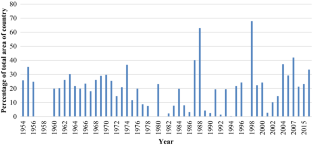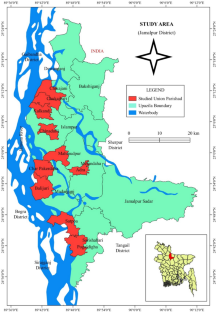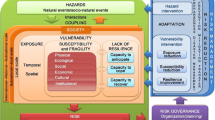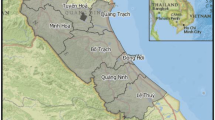Abstract
Floods are a frequent natural calamity in Bangladesh, where many areas get affected almost every year. An indicator-based vulnerability assessment can help efficiently manage the disaster. Therefore, this study intends to assess the community vulnerability in the Jamuna floodplain, one of the most flood-affected areas, using an indexing method. The index involves many indicators of flood exposure, sensitivity, and adaptive capacity along with their weights, determined based on an extensive literature review. A pretested questionnaire was employed to collect primary data from the study area through 400 household-level interviews. Using multistage sampling techniques, five upazilas from Jamalpur district, i.e., Dewanganj, Islampur, Madarganj, Melandaha, and Sharishabari, were purposefully chosen based on past flood damage reports. The percentage values were derived using SPSS for every variable from the field-level data. The variable vulnerability index (VVI) was computed by dividing the indicator’s weight by its percentage value. Then, exposure, sensitivity, and adaptive capacity indices were calculated using the VVI values. Finally, the composite vulnerability index (CVI) of the five Upazilas has been computed using an established and recognized index formula. The CVI scores for Dewanganj, Islampur, Madarganj, Melandaha, and Sharishabari are 0.86, 0.84, 0.71, 0.70, and 0.65, respectively, which suggest a high overall vulnerability. The scores of the exposure and adaptive capacity indices reveal that Dewanganj and Islampur Upazilas have higher vulnerability than the other three upazilas, especially due to poor socioeconomic conditions, low adaptive capacity, and high exposure. This study recommends some infrastructural development, such as sustainable flood-resistant dams, as the study sites are in a flood-prone zone. Houses should be built using flood-resistant materials like bricks and concrete, which are more resilient than mud. Improvements in education and multiple income sources will help the affected people increase their coping capacity.

(Source: BWDB)



Similar content being viewed by others
Data availability
Data will be available on reasonable request.
Code availability
Not applicable.
References
Adger WN (2006) Vulnerability. Glob Environ Change 16(3):268–281
Adger WN, Agnew M (2004) New indicators of vulnerability and adaptive capacity. Norwich: tyndall centre for climate change research. 122
Balica S, Wright NG (2010) Reducing the complexity of the flood vulnerability index. Environ Hazards 9(4):321–339
Balica SF, Douben N, Wright NG (2009) Flood vulnerability indices at varying spatial scales. Water Sci Technol 60(10):2571–2580
Balica SF, Wright NG, Van der Meulen F (2012) A flood vulnerability index for coastal cities and its use in assessing climate change impacts. Nat Hazards 64(1):73–105
Balica SF (2012) Applying the flood vulnerability index as a knowledge base for flood risk assessment; Dissertation, UNESCO-IHE institute for water education, delft
Batica J, Gourbesville P, Hu FY (2013) Methodology for flood resilience index. In: International conference on flood resilience experiences in Asia and Europe–ICFR, Exeter
BBS (2011) Bangladesh population and housing census 2011. Bangladesh Bureau of Statistics, Statistics and Informatics Division, Ministry of Planning, Government of the People's Republic of Bangladesh.
BBS (2017) Preliminary report on household income and expenditure survey 2016. Bangladesh Bureau of Statistics, Statistics and Informatics Division, Ministry of Planning, Government of the People's Republic of Bangladesh
Birkmann J (2007) Risk and vulnerability indicators at different scales: Applicability, usefulness and policy implications. Environ Hazards 7(1):20–31
Birkmann J, Cardona OD, Carreño ML, Barbat AH, Pelling M, Schneiderbauer S, Kienberger S, Keiler M, Alexander D, Zeil P, Welle T (2013) Framing vulnerability, risk and societal responses: the MOVE framework. Nat. Hazard 67(2):193–211
Borden KA, Schmidtlein MC, Emrich CT, Piegorsch WW, Cutter SL (2007) Vulnerability of US cities to environmental hazards. J Homel Secur Emerg Manag. https://doi.org/10.2202/1547-7355.1279
Bosher L, Dainty A, Carrillo P, Glass J, Price A (2009) Attaining improved resilience to floods a proactive multi-stakeholder approach. Disaster Prev Manage Int J. https://doi.org/10.1108/09653560910938501
Brammer H (1990) Floods in Bangladesh: geographical background to the 1987 and 1988 floods. Geogr j 156(1):12–22
Braun B, Aßheuer T (2011) Floods in megacity environments: vulnerability and coping strategies of slum dwellers in Dhaka/Bangladesh. Nat Hazards 58(2):771–787
Brouwer R, Akter S, Brander L, Haque E (2007) Socio-economic vulnerability and adaptation to environmental risk: a case study of climate change and flooding in Bangladesh. Risk Anal: Int J 27(2):313–326
Cutter SL, Barnes L, Berry M, Burton C, Evans E, Tate E, Webb J (2008) A place-based model for understanding community resilience to natural disasters. Glob Environ Chang 18(4):598–606
Cutter SL, Burton CG, Emrich CT (2010) Disaster resilience indicators for benchmarking baseline conditions. J homel secur emerg manage. https://doi.org/10.2202/1547-7355.1732
Cutter SL, Emrich CT, Morath DP, Dunning CM (2013) Integrating social vulnerability into federal flood risk management planning. J Flood Risk Manage 6(4):332–344
De León V, Carlos J (2006) Vulnerability: a conceptional and methodological review. UNU-EHS
Dufty N (2008) A new approach to community flood education. Aust J Emerg Manage 23(2):4–8
Fekete A, Brach K (2010) Assessment of social vulnerability river floods in Germany: united nations university. Institute for environment and human security (UNU-EHS)
Ferdous MR, Wesselink A, Brandimarte L, Slager K, Zwarteveen M, Di Baldassarre G (2019) The costs of living with floods in the Jamuna floodplain in Bangladesh. Water 11(6):1238
Field CB, Barros V, Stocker TF, Dahe Q (eds) (2012) Managing the risks of extreme events and disasters to advance climate change adaptation: special report of the intergovernmental panel on climate change. Cambridge University Press
Fuchs S (2009) Susceptibility versus resilience to mountain hazards in Austria-paradigms of vulnerability revisited. Nat Hazard 9(2):337–352
Fuchs S, Thaler T (eds) (2018) Vulnerability and resilience to natural hazards. Cambridge University Press
Gallopín, G. (2003). A sistemic synthesis of the relations between vulnerability, hazard, exposure and impact at policy identification. Economic commission for latin American and the Caribbean (ECLAC). Handbook for estimating the socio-economic and environmental effects of disasters. ECLAC. Mexico, DF, pp 2–5
Gwimbi P (2007) The effectiveness of early warning systems for the reduction of flood disasters: some experiences from cyclone induced floods in Zimbabwe. J Sustain Dev Afr 9(4):152–169
Haque MM, Islam S, Sikder MB, Islam MS (2022) Community flood resilience assessment in Jamuna floodplain: a case study in Jamalpur district Bangladesh. Int J Disaster Risk Reduct 72:102861
Hossain B, Sohel MS, Ryakitimbo CM (2020) Climate change induced extreme flood disaster in Bangladesh: implications on people’s livelihoods in the Char village and their coping mechanisms. Prog in Disaster Sci 6:100079
Karmaoui A, Balica SF, Messouli M (2016) Analysis of applicability of flood vulnerability index in Pre-Saharan region, a pilot study to assess flood in Southern Morocco. Nat Hazards Earth Syst Sci Discuss. https://doi.org/10.5194/nhess-2016-96
Khalil GM (1990) Floods in Bangladesh: a question of disciplining the rivers. Nat Hazards 3(4):379–401
Kienberger S, Lang S, Zeil P (2009) Spatial vulnerability units–expert-based spatial modelling of socio-economic vulnerability in the Salzach catchment, Austria. Nat Hazard 9(3):767–778
Kundzewicz ZW, Kanae S, Seneviratne SI, Handmer J, Nicholls N, Peduzzi P, Mechler R, Bouwer LM, Arnell N, Mach K, Robert Muir-Wood G, Brakenridge R, Kron W, Benito G, Honda Y, Takahashi K, Sherstyukov B (2014) Flood risk and climate change: global and regional perspectives. Hydrol Sci J 59(1):1–28
Ludy J, Kondolf GM (2012) Flood risk perception in lands “protected” by 100-year levees. Nat Hazards 61(2):829–842
Mayunga JS (2007) Understanding and applying the concept of community disaster resilience: a capital-based approach. Summer Acad Soc Vulnerability Resil Build 1(1):1–16
Mirza MMQ (2002) Global warming and changes in the probability of occurrence of floods in Bangladesh and implications. Glob Environ Chang 12(2):127–138
Mirza MMQ (2003) Climate change and extreme weather events: can developing countries adapt? Clim Policy 3(3):233–248
Mirza M, Warrick RA, Ericksen NJ (2003) The implications of climate change on floods of the Ganges, Brahmaputra and Meghna rivers in Bangladesh. Clim Change 57(3):287–318
Mondal MSH, Murayama T, Nishikizawa S (2021) Examining the determinants of flood risk mitigation measures at the household level in Bangladesh. Int J Disaster Risk Reduct 64:102492
Papathoma-Köhle M, Kappes M, Keiler M, Glade T (2011) Physical vulnerability assessment for alpine hazards: state of the art and future needs. Nat Hazards 58(2):645–680
Paul BK (1995) Farmers’ responses to the flood action plan (FAP) of Bangladesh: an empirical study. World Dev 23(2):299–309
Pelling M (2010) Adaptation to climate change: from resilience to transformation. Routledge
Piya, L., Maharjan, K. L., & Joshi, N. P. (2012). Vulnerability of rural households to climate change and extremes: analysis of Chepang households in the Mid-Hills of Nepal (No. 1007–2016–79495)
Qasim S, Khan AN, Shrestha RP, Qasim M (2015) Risk perception of the people in the flood prone Khyber Pukhthunkhwa province of Pakistan. Int J Disaster Risk Reduct 14:373–378
Qasim S, Qasim M, Shrestha RP, Khan AN (2017) An assessment of flood vulnerability in Khyber Pukhtunkhwa province of Pakistan. AIMS Environ Sci 4(2):206–216
Reynard NS, Prudhomme C, Crooks SM (2001) The flood characteristics of large UK rivers: potential effects of changing climate and land use. Clim Change 48(2):343–359
Scheuer S, Haase D, Meyer V (2011) Exploring multicriteria flood vulnerability by integrating economic, social and ecological dimensions of flood risk and coping capacity: from a starting point view towards an end point view of vulnerability. Nat Hazards 58(2):731–751
Shah AA, Ye J, Abid M, Khan J, Amir SM (2018) Flood hazards: household vulnerability and resilience in disaster-prone districts of Khyber Pakhtunkhwa province. Pak Nat Hazards 93(1):147–165
Shah AA, Shaw R, Ye J, Abid M, Amir SM, Pervez AK, Naz S (2019) Current capacities, preparedness and needs of local institutions in dealing with disaster risk reduction in Khyber Pakhtunkhwa, Pakistan. Int J Disaster Risk Reduct 34:165–172
Shah AA, Gong Z, Ali M, Jamshed A, Naqvi SAA, Naz S (2020a) Measuring education sector resilience in the face of flood disasters in Pakistan: an index-based approach. Environ Sci Pollut Res 27(35):44106–44122
Shah AA, Ye J, Shaw R, Ullah R, Ali M (2020b) Factors affecting flood-induced household vulnerability and health risks in Pakistan: the case of Khyber Pakhtunkhwa (KP) Province. Int J Disaster Risk Reduct 42:101341
Singha M, Dong J, Sarmah S, You N, Zhou Y, Zhang G, Doughty R, Xiao X (2020) Identifying floods and flood-affected paddy rice fields in Bangladesh based on Sentinel-1 imagery and Google Earth Engine. ISPRS J Photogramm Remote Sens 166:278–293
Solín Ľ, Madajová MS, Michaleje L (2018) Vulnerability assessment of households and its possible reflection in flood risk management: the case of the upper Myjava basin, Slovakia. Int J Disaster Risk Reduct 28:640–652
Sullivan C, Meigh J (2005) Targeting attention on local vulnerabilities using an integrated index approach: the example of the climate vulnerability index. Water Sci Technol 51(5):69–78
Tate E (2012) Social vulnerability indices: a comparative assessment using uncertainty and sensitivity analysis. Nat Hazards 63(2):325–347
Webster PJ, Jian J, Hopson TM, Hoyos CD, Agudelo PA, Chang HR, Curry JA, Grossman RL, Palmer TN, Subbiah AR (2010) Extended-range probabilistic forecasts of Ganges and Brahmaputra floods in Bangladesh. Bull Am Meteor Soc 91(11):1493–1514
Wisner B, Blaikie P, Cannon T, Davis I (2014) At risk: natural hazards, people’s vulnerability and disasters. Routledge
Younus MAF (2014) Flood vulnerability and adaptation to climate change in Bangladesh: a review. JEAPM 16(03):1450024
Acknowledgements
The authors express sincere thanks to Abdulla-Al Kafy and Digonresearch.org for their cordial help in proofreading of the manuscript. The first author received funding from the Ministry of Science and Technology, Government of the People’s Republic of Bangladesh, under the NST fellowship program.
Funding
The first author received funding from Ministry of Science and Technology, Government of the People’s Republic of Bangladesh under the NST fellowship program. Grant No. 39.00.0000.012.002.03.18.
Author information
Authors and Affiliations
Corresponding author
Ethics declarations
Conflict of interest
The authors declare no conflict of interest.
Additional information
Publisher's Note
Springer Nature remains neutral with regard to jurisdictional claims in published maps and institutional affiliations.
Rights and permissions
Springer Nature or its licensor (e.g. a society or other partner) holds exclusive rights to this article under a publishing agreement with the author(s) or other rightsholder(s); author self-archiving of the accepted manuscript version of this article is solely governed by the terms of such publishing agreement and applicable law.
About this article
Cite this article
Haque, M.M., Islam, S., Sikder, M.B. et al. Assessment of flood vulnerability in Jamuna floodplain: a case study in Jamalpur district, Bangladesh. Nat Hazards 116, 341–363 (2023). https://doi.org/10.1007/s11069-022-05677-1
Received:
Accepted:
Published:
Issue Date:
DOI: https://doi.org/10.1007/s11069-022-05677-1




